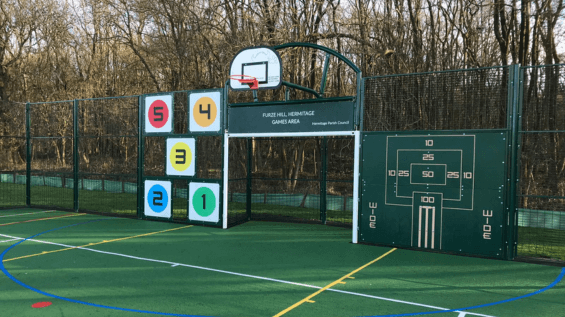
Sep

MAGAs vs MUGAs: Why Multi-Activity Game Areas Inspire Play for All
Most people are familiar with a MUGA (Multi Use Games Area), the large, fenced sports courts used for football, basketball, and tennis. They are excellent for organised sport, but not every school or community has the space, budget, or ongoing demand for such a facility.
This is where MAGAs (Multi-Activity Game Areas) come in. Instead of replicating a full-size pitch, MAGAs combine interactive walls, game panels, and ground markings to create versatile activity stations. They can be used in PE lessons, at break times, in parish play areas, or during unstructured play sessions, inspiring both exercise and imagination.
With research showing that only 47% of children and young people in England achieve the recommended average of 60 minutes of activity per day [Sport England, 2023], MAGAs represent a practical and engaging solution for schools and local councils seeking to encourage more daily movement.
What Is a Multi-Activity Game Area (MAGA)?
A MAGA is a compact, purpose-built space that blends equipment such as:
• Multi-active walls with targets, goal apertures, and rebound surfaces.
• Individual game panels offering skill-building challenges.
• Line markings for games like hopscotch, fitness trails, or ball-based activities.
Unlike MUGAs, which focus on formal team sports, MAGAs encourage a variety of games, from target shooting and ball control to agility challenges and reaction skills. They are designed to be flexible, inclusive, and suitable for both structured PE lessons and free play.
How MAGAs Differ from MUGAs
• Size and footprint: MUGAs require a significant land area, while MAGAs can be installed in smaller playgrounds or community spaces.
• Use: MUGAs serve organised sports; MAGAs encourage a mix of structured and unstructured activity.
• Inclusivity: MAGAs are suitable for all ages and abilities, offering accessible activities beyond competitive sport.
• Cost: MAGAs are more affordable to install and maintain compared with full-sized multi-sport facilities.
In short, MUGAs are perfect when the priority is organised sport, whereas MAGAs are ideal for schools and parishes that want variety, imagination, and accessibility in their play and activity provision.
Benefits of MAGAs in Schools
Supporting PE Lessons
MAGAs provide PE teachers with flexible tools to deliver engaging lessons. Panels and markings can be used for:
• Ball skills such as passing, shooting, and aiming.
• Agility and balance exercises using ground trails.
• Team-based drills to develop coordination and cooperation.
They allow teachers to break classes into smaller groups, maximising active time for every pupil. This supports the national curriculum’s emphasis on developing fundamental movement skills.
Break and Lunchtime Engagement
During unstructured times, MAGAs reduce playground conflicts by providing clear activity stations. Children naturally gravitate towards panels, targets, and markings, keeping them active and engaged.
Inclusivity in Play
Not every child enjoys competitive sport. MAGAs allow pupils to participate at their own level, whether it is practising throwing skills, inventing new games, or joining in low-pressure activities with friends. This helps schools meet inclusivity goals and promotes confidence in physical activity.
Benefits for Parish Councils and Community Spaces
Parish councils often face tight budgets and limited space when considering play facilities. A MAGA offers an ideal solution:
• Compact and cost-effective: can be installed on village greens, in local play parks, or alongside existing play equipment.
• Family-friendly: suitable for mixed ages, allowing younger children, teenagers, and even adults to engage in activities together.
• Community wellbeing: promotes active lifestyles at a time when public health priorities focus on reducing sedentary behaviour.
• Durability: built from robust, weather-resistant materials, MAGAs are designed to withstand heavy daily use with minimal maintenance.
Research from Fields in Trust shows that 6.1 million people in Great Britain do not have a park or green space within a 10-minute walk of home. (Fields in Trust, 2023) For smaller communities, investing in versatile play facilities like MAGAs helps ensure that accessible activity opportunities are available for all.
Structured and Unstructured Play
Structured Play
MAGAs can be integrated into organised sessions. Teachers, youth leaders, or sports coaches can use them for skill drills, competitive games, or circuit-style activities. For example:
• Target practice competitions.
• Relay races using line markings.
• Passing accuracy drills.
Unstructured Play
Perhaps their greatest strength lies in unstructured play. Children invent their own rules, create team challenges, or use the markings as part of imaginative games. This type of play supports creativity, resilience, and social development.
Both structured and unstructured play are vital, and MAGAs provide the perfect space for both.
Inspiring Imagination
MAGAs are open-ended by design. A rebound wall could be used for football shooting one moment, handball the next, and role-play as a “castle wall” during imaginative free play. Markings can guide fitness trails or be incorporated into invented games.
By encouraging creativity, MAGAs support not only physical development but also problem-solving, independence, and teamwork.
Suitability for All Ages
MAGAs are not limited to one age group:
• EYFS and Key Stage 1: basic motor skills, coordination, number-based games.
• Key Stage 2 and above: tactical play, accuracy challenges, team-building activities.
• Teenagers and adults: fitness drills, reaction challenges, and recreational play.
This broad appeal makes them valuable in both school and parish settings, where facilities need to serve multiple generations.
Practical Considerations
When considering a MAGA, schools and councils can take confidence in:
• Space efficiency: installations can be tailored to small playgrounds or larger parks.
• Safety: panels and markings comply with relevant EN standards.
• Durability: built with robust steel and resistant surfaces to deter vandalism.
• Cost-effectiveness: provides multiple activity opportunities without the expense of a full MUGA.
Why Choose Caloo for Your MAGA
Caloo has extensive experience working with schools, parishes, and local authorities to install MAGAs that inspire play and activity. Our service includes:
• Consultation-led design to match your space, budget, and user needs.
• A wide range of multi-active walls, panels, and markings to choose from.
• In-house installation teams ensuring quality and safety.
• Long-term support and maintenance to protect your investment.
Whether for a primary school playground or a parish recreation ground, Caloo provides the expertise and product range to create a truly versatile activity space.
Multi-Activity Game Areas are a modern, flexible solution for schools and communities seeking to increase daily activity, spark imagination, and provide inclusive opportunities for all. Unlike MUGAs, which focus on structured sport, MAGAs deliver variety, accessibility, and engagement in a compact, cost-effective format.
At a time when almost half of children in England do not meet recommended activity levels, facilities like MAGAs offer a practical way to encourage movement and wellbeing every day.
Contact Caloo today to arrange a free site consultation and discover how a Multi Activity Game Area could revitalise your playground or community space.
References
• Sport England, Active Lives Children and Young People Survey 2023
• Fields in Trust, Green Space Index 2023
• NHS England, Physical Activity and Health Guidance

















